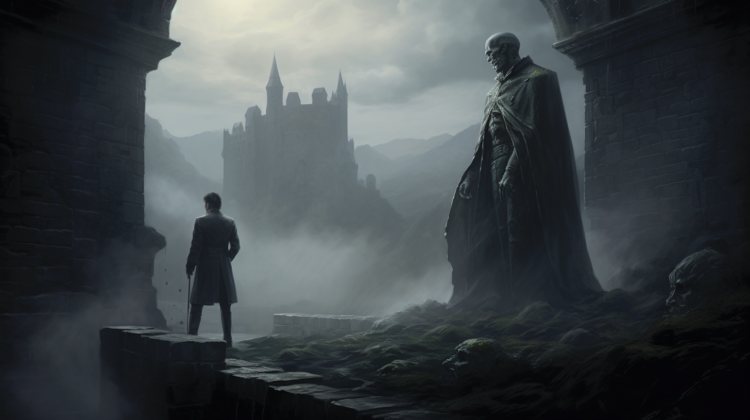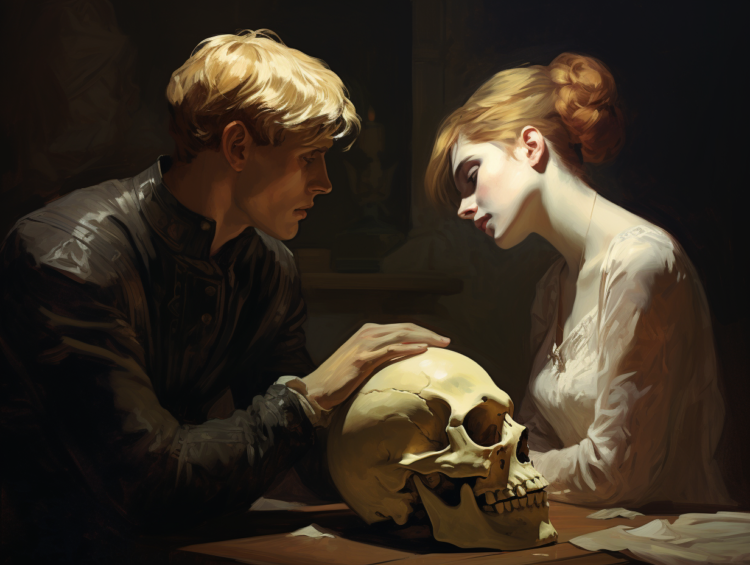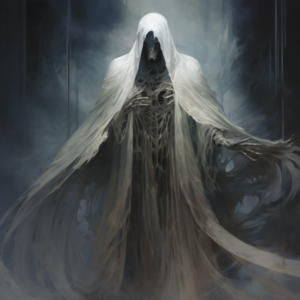 Delve into the enigmatic world of Shakespeare’s ‘Hamlet,’ a tale of betrayal and existential quandary set in Denmark’s Elsinore Castle. As we navigate the depths of Prince Hamlet’s psyche, this article offers a comprehensive or short summary, review, essential facts, and a treasure trove of insights into this timeless masterpiece.
Delve into the enigmatic world of Shakespeare’s ‘Hamlet,’ a tale of betrayal and existential quandary set in Denmark’s Elsinore Castle. As we navigate the depths of Prince Hamlet’s psyche, this article offers a comprehensive or short summary, review, essential facts, and a treasure trove of insights into this timeless masterpiece.
Brief Info About The Play
- Title of the Work: Hamlet
- Author: William Shakespeare
- Date of Publication: 1603 (First Quarto), though it’s believed to have been written between 1599 and 1601.
- Original Language: English
- Genre: Tragedy
- Form and Structure: Five-act play
- Setting: The Kingdom of Denmark during the late medieval period.
- Themes: Revenge, madness, moral corruption, mortality, the consequences of indecision.
- Publication Medium: Originally published as a quarto (a small booklet), later included in the First Folio of Shakespeare’s collected works in 1623.
- Diction: Mix of formal and poetic language, with some colloquialisms. The language can be considered archaic by modern standards. His word choices often carry deep connotations, reflecting the play’s complex themes and the psychological turmoil of its characters.
One Sentence Summary
The Prince of Denmark, spurred by his father’s ghost, grapples with betrayal by his uncle, leading to a tragic conclusion where both royal families meet their demise.
One Paragraph Short Summary of “Hamlet”
In the haunting realm of Shakespeare’s “Hamlet,” the ghost of the recently deceased King of Denmark appears to his son, Prince Hamlet, revealing that he was murdered by his own brother, now King Claudius. This revelation thrusts the young prince into a spiral of grief, anger, and profound introspection. As Hamlet devises a plan to confirm Claudius’s guilt, he feigns madness, leading to a series of tragic misunderstandings, manipulations, and confrontations. The play’s intricate web of deceit, moral ambiguity, and philosophical dilemmas culminate in a dramatic finale, where the royal court of Denmark, including Hamlet, Claudius, Queen Gertrude, and Ophelia, all meet tragic ends.
Comprehensive Summary of “Hamlet” act by act:
Act I: Ghostly Revelations
The play opens at Elsinore Castle in Denmark. The sentries, Marcellus and Barnardo, along with Horatio, a friend of Prince Hamlet, witness the ghost of the recently deceased King Hamlet. When the apparition appears to Prince Hamlet himself, it reveals that it is the spirit of his father and claims that he was murdered by his brother Claudius, who has now taken the throne and married Hamlet’s mother, Queen Gertrude. The ghost urges Hamlet to seek revenge.
Act II: Feigned Madness
Hamlet decides to feign madness as part of his plan to investigate the truth of the ghost’s accusations and to keep the king off guard. Ophelia, whom Hamlet has courted, reports his erratic behavior to her father, Polonius, who believes that Hamlet’s madness stems from unrequited love. Polonius decides to use Ophelia to get to the root of Hamlet’s strange behavior, setting the stage for further complications.
Act III: The Play Within a Play
Hamlet’s famous soliloquy, “To be or not to be,” delves deep into the theme of existence and the nature of suffering. Later, to confirm Claudius’s guilt, Hamlet stages a play that mimics the suspected circumstances of the old king’s death. Claudius’s reaction to the play reveals his guilt. Meanwhile, Hamlet’s relationship with Ophelia deteriorates, and he confronts his mother, during which he accidentally kills Polonius, thinking him to be Claudius.
Act IV: Exile and Madness
Following Polonius’s death, Hamlet is sent to England by Claudius, who plots to have him killed there. Ophelia, devastated by her father’s death and Hamlet’s behavior, descends into madness. Laertes, Polonius’s son, returns to Denmark to avenge his father’s death and sister’s madness. Claudius, sensing an ally in Laertes, plots with him to kill Hamlet.
Act V: A Graveyard, a Duel, and Deaths
In a graveyard, Hamlet encounters the skull of Yorick, the king’s jester from his childhood, leading to his reflection on the nature of life and death. Ophelia’s funeral procession arrives, and Hamlet realizes she is dead. A duel is arranged between Hamlet and Laertes. The duel, tainted by treachery, results in the deaths of Laertes, Hamlet, King Claudius, and Queen Gertrude. Fortinbras, the Norwegian prince, arrives as the carnage concludes, claiming the Danish throne.
Main Characters Review
Hamlet
The Prince of Denmark and the play’s protagonist. Hamlet is a deeply introspective and philosophical young man, torn between his duty to avenge his father’s murder and his doubts about the morality of such vengeance. His feigned madness, genuine grief, and sharp wit make him one of Shakespeare’s most complex and enduring characters.
King Claudius
The new King of Denmark and Hamlet’s uncle. Claudius is a cunning and manipulative ruler, responsible for the death of his brother, the former king. His guilt and paranoia are evident as the play progresses, especially in his interactions with Hamlet.
Queen Gertrude
Hamlet’s mother and the Queen of Denmark. She marries Claudius shortly after her first husband’s death. While her motivations and feelings remain somewhat ambiguous, her love for Hamlet is evident. She is often caught between her loyalty to Claudius and her concern for her son.
Ophelia
A young noblewoman of Denmark and Hamlet’s love interest. Ophelia is obedient to her father, Polonius, and is deeply affected by Hamlet’s erratic behavior. Her descent into madness and subsequent death are among the play’s most tragic moments.
Polonius
The Lord Chamberlain of Claudius’s court and the father of Ophelia and Laertes. Polonius is long-winded and fond of giving advice. He spies on Hamlet to determine the cause of the prince’s madness, leading to his accidental death at Hamlet’s hands.
Laertes
Polonius’s son and Ophelia’s brother. Laertes is passionate and quick to action. He returns to Denmark to avenge his father’s death and becomes a pawn in Claudius’s plot against Hamlet.
The Ghost
The spirit of Hamlet’s father, the former King of Denmark. The ghost reveals to Hamlet that he was murdered by Claudius and urges his son to seek revenge. The ghost’s appearance sets the events of the play into motion.
Horatio
Hamlet’s loyal friend and confidant. Horatio is level-headed and serves as a contrast to Hamlet’s introspection and impulsiveness. He is the only main character to survive the play’s tragic events and serves as the final narrator, ensuring that Hamlet’s story will be told.
Historical Backdrop And Context
“Hamlet” was written during the Elizabethan era, a period marked by a renewed interest in the arts, sciences, and the classics. The Renaissance was in full bloom in England, and the theater was a major form of entertainment. The play reflects the era’s fascination with themes of death, revenge, and the supernatural. Additionally, the political intrigues and betrayals in the play mirror the political climate of Shakespeare’s time, with its power struggles and shifting alliances.
Shakespeare’s Portfolio Compared With Hamlet
While many of Shakespeare’s plays explore themes of love, betrayal, and political intrigue, “Hamlet” stands out for its deep psychological insight and complex moral issues. Unlike the romantic comedy of “A Midsummer Night’s Dream” or the historical drama of “Julius Caesar,” “Hamlet” delves into the human psyche, exploring the inner turmoil of its titular character. The play’s exploration of madness, both real and feigned, also sets it apart from other works like “Macbeth” or “Othello.”
Audience Reception
Upon its initial performances, “Hamlet” was well-received by audiences and has since become one of Shakespeare’s most performed and studied plays. Over the centuries, critics have debated various aspects of the play, from Hamlet’s character and motivations to the play’s themes of death and revenge. Modern interpretations often focus on its psychological depth, exploring the complexities of its characters and their moral dilemmas.
Notable Adaptations of “Hamlet”
These adaptations, among many others, showcase the enduring influence and versatility of “Hamlet,” proving its ability to inspire and captivate audiences across different cultures and eras.
Film:
- “Hamlet” (1948) directed by Laurence Olivier – This adaptation won four Academy Awards, including Best Picture and Best Actor for Olivier.
- “Hamlet” (1990) directed by Franco Zeffirelli – Featuring Mel Gibson in the titular role and Glenn Close as Queen Gertrude.
- “Hamlet” (1996) directed by Kenneth Branagh – A complete and uncut version of the play, it boasts a star-studded cast including Branagh himself as Hamlet.
- “Hamlet 2” (2008) – A comedic take on the story, this film revolves around a high school drama teacher who writes a sequel to “Hamlet.”
Television:
“Hamlet” (2009) – A TV film for BBC starring David Tennant as Hamlet and Patrick Stewart as King Claudius.
Theatre:
“Rosencrantz and Guildenstern Are Dead” (1966) by Tom Stoppard – A play that focuses on two minor characters from “Hamlet,” offering a comedic and existentialist take on the events of the original play.
Ballet:
“Hamlet” by American Ballet Theatre – A modern ballet interpretation of the classic tale.
Literature:
“The Story of Edgar Sawtelle” (2008) by David Wroblewski – A novel that is a retelling of “Hamlet” set in rural Wisconsin.
Music:
“Hamlet” by Ambroise Thomas – An opera based on the Shakespearean tragedy.
Visual Art:
Paintings by Eugène Delacroix – The 19th-century Romantic artist created several works inspired by scenes from “Hamlet,” most notably his depiction of Hamlet and Horatio in the graveyard.
Literary Landscape of The Hamlet Time
“Hamlet” is often compared to other tragedies of its time, such as Christopher Marlowe’s “Doctor Faustus,” which also delves into themes of ambition, the supernatural, and moral consequence. However, “Hamlet” stands out for its intricate character development and its exploration of existential themes. Within Shakespeare’s own works, plays like “Macbeth” and “Othello” offer similar explorations of ambition, betrayal, and the tragic consequences of flawed decision-making, but “Hamlet” remains distinct in its deep philosophical introspection.
Intriguing Tidbits about “Hamlet”
These fascinating aspects of “Hamlet” offer a deeper appreciation for the play’s richness and its lasting imprint on culture and literature.
- “To be or not to be”: This soliloquy from “Hamlet” is one of the most quoted lines in the English language, showcasing Shakespeare’s profound impact on literature and popular culture.
- Yorick’s Skull: The scene where Hamlet holds the skull of Yorick, the court jester from his childhood, has been referenced and parodied in countless other works, from literature to film and even cartoons.
- Longest Play: “Hamlet” is Shakespeare’s longest play with over 4,000 lines, which translates to about four hours of stage time.
- Ophelia’s Flowers: Ophelia’s distribution of flowers in Act IV has been the subject of much scholarly debate, with each flower believed to have a symbolic meaning, from rosemary for remembrance to pansies for thoughts.
- Multiple Versions: There are three different versions of “Hamlet” that have survived to the present day: the First Quarto (Q1), the Second Quarto (Q2), and the First Folio (F1). Each version has differences in text, with some lines unique to each version.
- The “Hamlet” Curse: Some actors and theater enthusiasts believe in a superstition that saying the name “Hamlet” inside a theater, except during a rehearsal or performance, is bad luck. Instead, they refer to it as “The Scottish Play.”
- Influence on Modern Works: The Lion King, a popular Disney animated film, has several plot elements and character arcs inspired by “Hamlet.”
My Thoughts on “Hamlet”
Shakespeare’s ‘Hamlet’ is often hailed as a pinnacle of dramatic literature, but strip away the prestige and what remains? A moody prince, a ghostly dad, and a lot of existential musing. The play’s endless introspection and Hamlet’s incessant vacillation can come off as mere procrastination rather than profound philosophy. Is it possible that the world’s most famous play is, at its heart, a tale of a young man who simply can’t make up his mind? Perhaps Shakespeare is laughing in his grave at all of us trying to find deep meaning in every “To be or not to be”.
Have thoughts on “Hamlet”? I’d love to hear your take! Share your insights and opinions in the comments below.








Comments